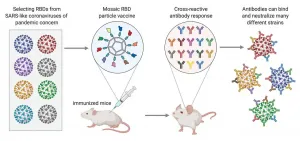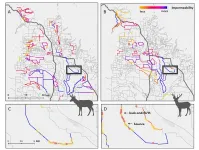(Press-News.org) Researchers at University of California San Diego School of Medicine, in collaboration with Dutch scientists, have found that certain metabolites -- small molecules produced by the process of metabolism -- may be predictive indicators for persons at risk for recurrent major depressive disorder.
The findings were published in the January 11, 2021 online issue of Translational Psychiatry.
"This is evidence for a mitochondrial nexus at the heart of depression," said senior author Robert K. Naviaux, MD, PhD, professor of medicine, pediatrics and pathology at UC San Diego School of Medicine. "It's a small study, but it is the first to show the potential of using metabolic markers as predictive clinical indicators of patients at greatest risk -- and lower risk -- for recurring bouts of major depressive symptoms."
Recurrent major depressive disorder (in lay terms, clinical depression) is a mood disorder characterized by multiple symptoms in combination: feelings of sadness or hopelessness, anger or frustration, loss of interest, sleep disturbances, anxiety, slowed or difficulty thinking, suicidal thoughts and unexplained physical problems, such as back pain or headaches.
Major depressive disorder (MDD) is among the most common mental illnesses in the United States, with an estimated lifetime prevalence of 20.6 percent, meaning one in five Americans will suffer at least one episode during their lives. For patients who have recurrent MDD (rMDD), the five-year recurrence risk is up to 80 percent.
For their study, Naviaux and colleagues in The Netherlands recruited 68 subjects (45 females, 23 males) with rMDD who were in antidepressant-free remission and 59 age- and gender-matched controls. After collecting blood from patients who were in remission, the patients were followed prospectively for two-and-a-half years.
Results showed that a metabolic signature found when patients were well could predict which patients were most likely to relapse up to two-and-a-half years in the future. The accuracy of this prediction was more than 90 percent. Analysis of the most predictive chemicals found they belong to certain kinds of lipids (fats that included eicosanoids and sphingolipids) and purines.
Purines are made from molecules, such as ATP and ADP -- the major chemicals used for energy storage in cells, but which also play a role in communications used by cells under stress, known as purinergic signaling.
The researchers found that in subjects with rMDD, changes in specific metabolites in six identified metabolic pathways resulted in fundamental alterations of important cellular activities.
"The findings revealed an underlying biochemical signature in remitted rMDD that set diagnosed patients apart from healthy controls," said Naviaux. "These differences are not visible through ordinary clinical assessment, but suggest that the use of metabolomics -- the biological study of metabolites -- could be a new tool for predicting which patients are most vulnerable to a recurrence of depressive symptoms."
The authors noted that their initial findings require validation in a larger study of at least 198 females and 198 males (99 cases and 99 controls each).
INFORMATION:
Co-authors include: Roel J.T. Mocking, Caroline A. Figueroa and Johanna Assies, University of Amsterdam, The Netherlands; Jane C. Naviaux, Kefeng Li, Lin Wang, Jonathan M. Monk, and A. Taylor Bright, UC San Diego; Aart H. Schene, Radboud University Medical Center, The Netherlands; and Henricus G. Ruhe, University of Amsterdam and Radboud University Medical Center, The Netherlands.
New Rochelle, NY, January 12, 2021--The Centers for Disease Control and Prevention (CDC) is committed to removing unnecessary medical barriers to contraception use by people with certain characteristics or medical conditions. The CDC is celebrating the 10th anniversary of the release of its U.S. Medical Eligibility Criteria for Contraceptive Use (MEC), with an exclusive article published in the peer-reviewed Journal of Women's Health. Click here to read the article now.
The CDC has updated the MEC recommendations over the past decade based on new evidence. It has collaborated with national partners to disseminate and implement the guidelines and has conducted surveys of health ...
The SARS-CoV-2 virus that is causing the COVID-19 pandemic is just one of many different viruses in the coronavirus family. Many of these are circulating in populations of animals like bats and have the potential to "jump" into the human population, just as SARS-CoV-2 did. Researchers in the laboratory of Pamela Björkman, the David Baltimore Professor of Biology and Bioengineering, are working on developing vaccines for a wide range of related coronaviruses, with the aim of preventing future pandemics.
Now, led by graduate student Alex Cohen, a Caltech ...
Berkeley -- Each year, thousands of migratory mule deer and pronghorn antelope journey northwest from their winter homes in the Green River Basin, a grassland valley in western Wyoming, to their summer homes in the mountainous landscape near Grand Teton National Park.
But to reach their destination, these ungulates must successfully navigate the more than 6,000 kilometers (3,728 miles) of fencing that crisscrosses the region. That's enough distance to span nearly twice the length of the U.S.-Mexico border.
In a new study, wildlife biologists at the University of California, Berkeley, combined GPS location data of tagged mule deer and pronghorn with satellite imagery of ...
Curiosity has been found to play a role in our learning and emotional well-being, but due to the open-ended nature of how curiosity is actually practiced, measuring it is challenging. Psychological studies have attempted to gauge participants' curiosity through their engagement in specific activities, such as asking questions, playing trivia games, and gossiping. However, such methods focus on quantifying a person's curiosity rather than understanding the different ways it can be expressed.
Efforts to better understand what curiosity actually looks like for different people have underappreciated roots in the field of philosophy. Varying styles have been described with loose ...
A lurking threat that has stymied US corn growers for decades is now returning to the forefront: western corn rootworm. Sometimes referred to as the "billion-dollar bug," the species' tiny larvae chew through the roots of corn plants, causing devastating yield losses. In 2003, farmers began planting a genetically engineered variety of corn known as "Bt," which produces a protein toxic to the pest species - but by 2009, the billion-dollar bug had already evolved adaptations for resistance to the toxin.
A new study suggests that slowing the resurgence of western corn rootworm may require a larger-scale strategy than previously thought. The findings, ...
BOSTON - While investigating the underlying causes of a rare skin disorder, a researcher at Massachusetts General Hospital (MGH) discovered a previously unknown mechanism in the kidneys that is important for regulating levels of magnesium and calcium in the blood.
The discovery, described in the journal Cell Reports, highlights the role of a previously little-studied gene called KCTD1. The gene directs production of a protein that regulates the kidney's ability to reabsorb magnesium and calcium from urine and return it to the bloodstream.
A genetic mutation causing the loss of KCTD1 results in defects in nephrons, ...
You've heard of Old Faithful, the Yellowstone National Park geyser that erupts every hour or two, a geological phenomenon on a nearly predictable schedule.
Now, an international group of scientists who study space have discovered an astronomical "Old Faithful" - an eruption of light flashing about once every 114 days on a nearly predictable schedule. The researchers believe it is a tidal disruption event, a phenomenon that happens when a star gets so close to a black hole that the black hole "rips" away pieces of the star, causing the flare.
The team made the discovery using data from NASA and from a network of telescopes operated by The Ohio State University.
Their findings, presented today at the Astronomical Society's annual meeting and accepted for publication ...
Researchers have found a simple way to eliminate almost all sequencing errors produced by a widely used portable DNA sequencer, potentially enabling scientists working outside the lab to study and track microorganisms like the SARS-CoV-2 virus more efficiently.
Using special molecular tags, the team was able to reduce the five-to-15 per cent error rate of Oxford Nanopore Technologies' MinION device to less than 0.005 per cent -- even when sequencing many long stretches of DNA at a time.
"The MinION has revolutionized the field of genomics by freeing DNA sequencing from the confines of large laboratories," says Ryan Ziels, an ...
Scientists have used gene-editing advances to achieve a tenfold increase in the production of super-bug targeting formicamycin antibiotics.
The John Innes Centre researchers used the technology to create a new strain of Streptomyces formicae bacteria which over-produces the medically promising molecules.
Discovered within the last ten years, formicamycins have great potential because, under laboratory conditions, superbugs like MRSA do not become resistant to them.
However, Streptomyces formicae only produce the antibiotics in small quantities. This has made it difficult to scale up ...
ITHACA, NY - Invasive round goby fish have impacted fisheries in the Great Lakes and the Finger Lakes by competing with native species and eating the eggs of some species of game fish.
But the camouflaged bottom dwellers can be difficult to find and collect - especially when they first enter a new body of water and their numbers are low and they might be easier to remove.
In a proof-of-principle study, Cornell researchers describe a new technique in which they analyzed environmental DNA - or eDNA - from water samples in Cayuga Lake to gather nuanced information about the presence of these invasive fish.
The study, "Nuclear eDNA Estimates Population Allele Frequencies and Abundance in Experimental Mesocosms and Field Samples," was ...






